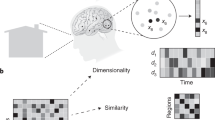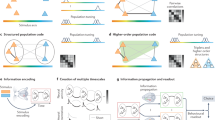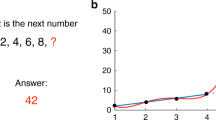Abstract
It has been more than 20 years since Bialek and colleagues published a landmark paper asking a seemingly innocuous question: what can we extract about the outside world from the spiking activity of sensory neurons? Can we read the neural code? Although this seemingly simple question has helped us shed light on the neural code, we still do not understand the anatomical and neurophysiological constraints that enable these codes to propagate across synapses and form the basis for computations that we need to interact with our environment. The sensitivity of neuronal activity to the timing of synaptic inputs naturally suggests that synchrony determines the form of the neural code, and, in turn, regulation of synchrony is a critical element in 'writing' the neural code through the artificial control of microcircuits to activate downstream structures. In this way, reading and writing the neural code are inextricably linked.
This is a preview of subscription content, access via your institution
Access options
Subscribe to this journal
Receive 12 print issues and online access
$209.00 per year
only $17.42 per issue
Buy this article
- Purchase on Springer Link
- Instant access to full article PDF
Prices may be subject to local taxes which are calculated during checkout
Similar content being viewed by others
References
Georgopoulos, A.P., Kettner, R.E. & Schwartz, A.B. Primate motor cortex and free arm movements to visual targets in three-dimensional space. II. Coding of the direction of movement by a neuronal population. J. Neurosci. 8, 2928–2937 (1988).
Paradiso, M.A. A theory for the use of visual orientation information which exploits the columnar structure of striate cortex. Biol. Cybern. 58, 35–49 (1988).
Britten, K.H., Shadlen, M.N., Newsome, W.T. & Movshon, J.A. The analysis of visual motion: a comparison of neuronal and psychophysical performance. J. Neurosci. 12, 4745–4765 (1992).
Bialek, W., Rieke, F., de Ruyter van Steveninck, R.R. & Warland, D. Reading a neural code. Science 252, 1854–1857 (1991).
Creutzfeldt, O.D. & Nothdurft, H.C. Representation of complex visual stimuli in the brain. Naturwissenschaften 65, 307–318 (1978).
Warland, D.K., Reinagel, P. & Meister, M. Decoding visual information from a population of retinal ganglion cells. J. Neurophysiol. 78, 2336–2350 (1997).
Stanley, G.B., Li, F.F. & Dan, Y. Reconstruction of natural scenes from ensemble responses in the lateral geniculate nucleus. J. Neurosci. 19, 8036–8042 (1999).
Brown, E.N., Frank, L.M., Tang, D., Quirk, M.C. & Wilson, M.A. A statistical paradigm for neural spike train decoding applied to position prediction from ensemble firing patterns of rat hippocampal place cells. J. Neurosci. 18, 7411–7425 (1998).
Zhang, K., Ginzburg, I., McNaughton, B.L. & Sejnowski, T.J. Interpreting neuronal population activity by reconstruction: unified framework with application to hippocampal place cells. J. Neurophysiol. 79, 1017–1044 (1998).
Miyawaki, Y. et al. Visual image reconstruction from human brain activity using a combination of multiscale local image decoders. Neuron 60, 915–929 (2008).
Quian Quiroga, R. & Panzeri, S. Extracting information from neuronal populations: information theory and decoding approaches. Nat. Rev. Neurosci. 10, 173–185 (2009).
Shadlen, M.N. & Newsome, W.T. The variable discharge of cortical neurons: implications for connectivity, computation, and information coding. J. Neurosci. 18, 3870–3896 (1998).
Fellous, J.-M., Tiesinga, P.H.E., Thomas, P.J. & Sejnowski, T.J. Discovering spike patterns in neuronal responses. J. Neurosci. 24, 2989–3001 (2004).
Bazhenov, M., Rulkov, N.F., Fellous, J.-M. & Timofeev, I. Role of network dynamics in shaping spike timing reliability. Phys. Rev. E 72, 041903 (2005).
Jacobs, A.L. et al. Ruling out and ruling in neural codes. Proc. Natl. Acad. Sci. USA 106, 5936–5941 (2009).
Van Rullen, R. & Thorpe, S.J. Rate coding versus temporal order coding: what the retinal ganglion cells tell the visual cortex. Neural Comput. 13, 1255–1283 (2001).
Gollisch, T. & Meister, M. Rapid neural coding in the retina with relative spike latencies. Science 319, 1108–1111 (2008).
Zohary, E., Shadlen, M.N. & Newsome, W.T. Correlated neuronal discharge rate and its implications for psychophysical performance. Nature 370, 140–143 (1994).
Abbott, L.F. & Dayan, P. The effect of correlated variability on the accuracy of a population code. Neural Comput. 11, 91–101 (1999).
Nirenberg, S. & Latham, P.E. Decoding neuronal spike trains: how important are correlations? Proc. Natl. Acad. Sci. USA 100, 7348–7353 (2003).
Schneidman, E., Bialek, W. & Berry, M.J. Synergy, redundancy, and independence in population codes. J. Neurosci. 23, 11539–11553 (2003).
Wang, H.-P., Spencer, D., Fellous, J.-M. & Sejnowski, T.J. Synchrony of thalamocortical inputs maximizes cortical reliability. Science 328, 106–109 (2010).
Alonso, J.M., Usrey, W.M. & Reid, R.C. Precisely correlated firing in cells of the lateral geniculate nucleus. Nature 383, 815–819 (1996).
Bruno, R.M. & Sakmann, B. Cortex is driven by weak but synchronously active thalamocortical synapses. Science 312, 1622–1627 (2006).
Brette, R. Computing with neural synchrony. PLoS Comput. Biol. 8, e1002561 (2012).
Swadlow, H.A. & Gusev, A.G. Receptive-field construction in cortical inhibitory interneurons. Nat. Neurosci. 5, 403–404 (2002).
Gabernet, L., Jadhav, S.P., Feldman, D.E., Carandini, M. & Scanziani, M. Somatosensory integration controlled by dynamic thalamocortical feed-forward inhibition. Neuron 48, 315–327 (2005).
Butts, D.A. et al. Temporal precision in the neural code and the timescales of natural vision. Nature 449, 92–95 (2007).
Stanley, G.B. et al. Visual orientation and directional selectivity through thalamic synchrony. J. Neurosci. 32, 9073–9088 (2012).
Chase, S.M. & Young, E.D. First-spike latency information in single neurons increases when referenced to population onset. Proc. Natl. Acad. Sci. USA 104, 5175–5180 (2007).
Johansson, R.S. & Birznieks, I. First spikes in ensembles of human tactile afferents code complex spatial fingertip events. Nat. Neurosci. 7, 170–177 (2004).
Masquelier, T. Relative spike time coding and STDP-based orientation selectivity in the early visual system in natural continuous and saccadic vision: a computational model. J. Comput. Neurosci. 32, 425–441 (2012).
Smith, M.A. & Kohn, A. Spatial and temporal scales of neuronal correlation in primary visual cortex. J. Neurosci. 28, 12591–12603 (2008).
Ohiorhenuan, I.E. et al. Sparse coding and high-order correlations in fine-scale cortical networks. Nature 466, 617–621 (2010).
Desbordes, G. et al. Timing precision in population coding of natural scenes in the early visual system. PLoS Biol. 6, e324 (2008).
Sherman, S.M. A wake-up call from the thalamus. Nat. Neurosci. 4, 344–346 (2001).
Lesica, N.A. & Stanley, G.B. Encoding of natural scene movies by tonic and burst spikes in the lateral geniculate nucleus. J. Neurosci. 24, 10731–10740 (2004).
Lesica, N.A. et al. Dynamic encoding of natural luminance sequences by LGN bursts. PLoS Biol. 4, e209 (2006).
Halassa, M.M. et al. Selective optical drive of thalamic reticular nucleus generates thalamic bursts and cortical spindles. Nat. Neurosci. 14, 1118–1120 (2011).
Wang, Q., Webber, R.M. & Stanley, G.B. Thalamic synchrony and the adaptive gating of information flow to cortex. Nat. Neurosci. 13, 1534–1541 (2010).
Bernstein, J.G. et al. Prosthetic systems for therapeutic optical activation and silencing of genetically-targeted neurons. Proc. Soc. Photo Opt. Instrum. Eng. 6854, 68540H (2008).
Butovas, S. & Schwarz, C. Spatiotemporal effects of microstimulation in rat neocortex: a parametric study using multielectrode recordings. J. Neurophysiol. 90, 3024–3039 (2003).
Wang, Q., Millard, D.C., Zheng, H.J.V. & Stanley, G.B. Voltage-sensitive dye imaging reveals improved topographic activation of cortex in response to manipulation of thalamic microstimulation parameters. J. Neural Eng. 9, 026008 (2012).
Gunaydin, L.A. et al. Ultrafast optogenetic control. Nat. Neurosci. 13, 387–392 (2010).
Stoelzel, C.R., Bereshpolova, Y. & Swadlow, H.A. Stability of thalamocortical synaptic transmission across awake brain states. J. Neurosci. 29, 6851–6859 (2009).
Barlow, H. Possible principles underlying the transformation of sensory messages. in Sensory Communication (ed. Rosenbluth, W.A.) 217–234 (MIT Press, Cambridge, Massachusetts, USA, 1961).
Sharma, J., Angelucci, A. & Sur, M. Induction of visual orientation modules in auditory cortex. Nature 404, 841–847 (2000).
Lesica, N.A. et al. Adaptation to stimulus contrast and correlations during natural visual stimulation. Neuron 55, 479–491 (2007).
Seki, K. & Fetz, E.E. Gating of sensory input at spinal and cortical levels during preparation and execution of voluntary movement. J. Neurosci. 32, 890–902 (2012).
Szuts, T.A. et al. A wireless multi-channel neural amplifier for freely moving animals. Nat. Neurosci. 14, 263–269 (2011).
Acknowledgements
I would like to thank D.A. Butts, J.-M. Alonso, C. Schwarz and D.C. Millard for comments on the manuscript. G.B.S. was supported by US National Science Foundation Collaborative Research in Computational Neuroscience grants IIS-0904630 and IOS-1131948, and US National Institutes of Health National Institute of Neurological Disorders and Stroke grant 2R01NS048285.
Author information
Authors and Affiliations
Corresponding author
Ethics declarations
Competing interests
The author declares no competing financial interests.
Rights and permissions
About this article
Cite this article
Stanley, G. Reading and writing the neural code. Nat Neurosci 16, 259–263 (2013). https://doi.org/10.1038/nn.3330
Received:
Accepted:
Published:
Issue Date:
DOI: https://doi.org/10.1038/nn.3330
This article is cited by
-
Flexible brain–computer interfaces
Nature Electronics (2023)
-
Biological Codes: A Field Guide for Code Hunters
Biological Theory (2023)
-
New Labels for Old Ideas: Predictive Processing and the Interpretation of Neural Signals
Review of Philosophy and Psychology (2020)
-
Dynamic contrast enhancement and flexible odor codes
Nature Communications (2018)
-
Fundamental Limits of Forced Asynchronous Spiking with Integrate and Fire Dynamics
The Journal of Mathematical Neuroscience (2017)



